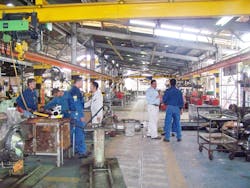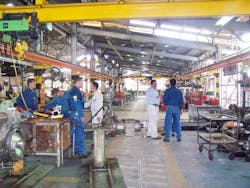As an industrial asset, the process pump mated to an electric motor is the world’s most popular piece of rotating equipment. Pumps far outnumber compressors, mixers, fans, blowers, internal combustion engines, turbines and gearboxes, while in some process plants representing as much as 85 percent of all rotating equipment.
Admittedly, slightly more electric motors exist in the world than pumps. About 90 percent of all industrial electric motors are mated to a pump, while also being used to drive fans, compressors and other equipment.
Pumps and motors share many design features. Both, for example, are mounted within cast housings. A pump and a motor each have one moving component, the rotating shaft. In both cases, the shaft is steadied with a set of precision bearings. The pump shaft end and the motor shaft end are connected with a coupling. Electricity passes through the motor. Liquid passes through the pump.
Generally, the electric motors go to the electric shop for repair. Pumps receive care in the mechanical maintenance shop, often called the pump shop. A better term might be "pump hospital."
On sick leave
If you should visit the maintenance bay at an oil refinery, sugar mill, fossil fuel power plant or chemical plant, you would immediately notice that the pump shop is three to 10 times larger than the electric shop. The space allotted to sick motors is small compared to the space allotted to sick pumps.
There are a few reasons for this:
- Electricians receive ongoing training. Maintenance training for equipment such as pumps is sporadic at best and eliminated completely in a down economy or when the bean-counters want to improve the balance sheet in preparation for a corporate merger or sale.
- Electricians gather information with a circuit tester and multi-meter before reaching for their screwdrivers. Most mechanics reach for the wrench before gathering information.
- Electrical types understand and effectively manage their motors better than the mechanical types and operators do their pumps.
- An electric motor performance curve is easier to interpret than a pup performance curve.
- Electricians and electrical engineers don’t make use of the term “bad actor” motors.
Frequently, the deck is stacked against the mechanics and operators. How can they understand a performance curve when the original specifying engineer didn’t order sufficient instrumentation such as pressure gauges or flow meters for the pump? This is like driving a car without a dashboard.
Actually, there are some rules, clues and hints that any mechanic can use to predict the health of his pumps and that any operator can use to control his pumps.
Another electric shop and pump shop at the same South American oil refinery.
Some truisms
The piping system is the master. The pump is the slave. The pipe system — including pipes, valves, fittings and accessories — controls the pump. The pump reacts to the system.
Water has been and always will be the No. 1 liquid transported in bulk with a pump. In the past century, centrifugal pumps have displaced positive displacement pumps as the type most likely to be used to move water. The same goes for other liquids that behave like water when flowing through pipes, such as milk, gasoline, vinegar and alcohol.
Pumps add energy to a liquid. The units of added energy are called "head" and are measured in feet or meters. Most pumps use this added energy to elevate the liquids receiving the energy. Sometimes a pump is used to accelerate a liquid’s velocity through a pipe. Sometimes the pump is employed to increase the liquid’s pressure. Pump manufacturers print performance curves of their pumps showing head in feet to express the added elevation, acceleration or pressure.
Pressure is a force applied to an area, such as a pound of force applied to a square inch of area (psi). Pump users including process engineers, mechanics and operators use pressure gauge readings in psi to express the added energy in its forms including pressure, acceleration and/or elevation.
The pump user must understand head and pressure to communicate with the pump factory, and to interpret the performance curve with instrumentation. The conversion factor 2.31 converts pressure into head and head back into pressure.
For water the formula is:
Head (feet) = Pressure (psi) • 2.31
Pressure (psi) = Head (feet)
2.31
If the liquid is not water, then the liquid’s specific gravity must be factored into the formula. Here is an example using cold water: Most suburban communities will have an elevated tank of treated municipal water in their vicinity that supplies water pressure to the neighborhoods below the tank. Let’s say the water level in the elevated tank is 140 feet above a kitchen faucet in one of the homes. What is the water pressure at the faucet? 140/2.31 = 60 psi.
There would be 60 psi of water pressure available to the faucet just because the water level in the elevated tank is 140 feet above the faucet. As the faucet is opened and water begins moving through the pipes, there would be a slight (maybe unnoticeable) pressure drop due to friction between the water and the pipe’s internal walls.
Almost every process plant has a cooling tower. Let’s say the tower is 30 feet tall above the reservoir under the tower. The recirculation pump under the tower should develop 13 psi of differential pressure to push the water to the top of the tower (Δpsi = 30 feet/ 2.31).
Final words
In my work as a pump consultant, I see pumps with no instrumentation. Occasionally, I see a pressure gauge with a fogged or broken cover glass. This is a shame because, while a simple gauge is missing or broken, the reliability engineer is chasing undetermined vibrations. The bean counters wonder why the maintenance shop is so large compared to the electric motor shop, and that’s the way it is.
The Pump Guy is Larry Bachus, a pump consultant, lecturer, author and inventor based in Nashville, Tennessee. He is a retired member of ASME and lectures in English and Spanish. He may be reached at [email protected].

